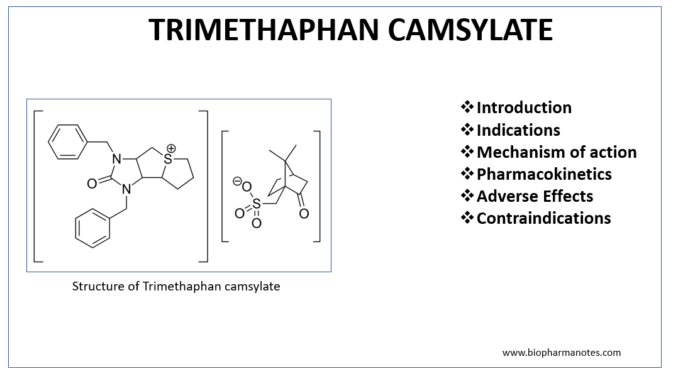
Introduction of Trimethaphan
Trimethaphan is ganglionic blocking agent. It is used as nicotinic antagonist in hypertension. It inhibits both sympathetic and parasympathetic autonomic activity. Trimethaphan was marketed under the brand name Arfonad. It is also known as Trimethaphan camsylate.
It belongs to class of organic compounds known as thienoimidazolidines. These are heterocyclic compounds consisting of thiophene ring fused with imidazolidine ring.
Indications of trimethaphan
Its use is rare due to its serious adverse effects resulting from autonomic blockade. It is used in some specific cases like:
- Used to produce controlled hypotension for short period, during surgery, due to its extremely transient action.
- Used in hypertension associated with dissecting aortic aneurysm.
- Also used during nitroprusside resistance or toxicity.
- In hypertensive emergencies.
- Used in absence of alternative effective therapy for hypertension.
Mechanism of action of trimethaphan
- Trimethaphan competitively block the nicotinic receptor in both sympathetic and parasympathetic ganglia. Hence, it inhibits binding of acetylcholine to postsynaptic receptor and inhibit stimulation of these receptors. It also induces direct peripheral vasodilation and release histamine.
- The vasodilation effect and reduction in sympathetic tone is responsible for its hypotensive effect.
Adverse effects
- It causes non-specific blockade of both sympathetic and parasympathetic system which is the reason for many adverse effects.
- Postural hypotension is common side effect due to sympathetic blockade. Parasympathetic blockade may cause visual disturbance, dry mouth, constipation, nausea, exacerbation of glaucoma, respiratory depression, urinary retention, sexual impotence etc. It can decrease force of contraction and increase heart rate. Tachyphylaxis may develop within 24- 48 hours.
- Due to its frequent and severe side effects and availability of new drugs with better safety profile, its use is limited to life-threatening disorder.
Pharmacokinetics
- It is given by continuous infusion. The onset of action is within 1 to 2 minutes and duration of action is around 10 minutes. Constant monitoring of BP is required after its administration due to dramatic reduction in BP.
- It is generally administered in supine position to avoid risk of postural hypotension.
Contraindications
- As it causes impairment of pupillary reflexes, it is contraindicated in patients who require neurological monitoring.
- Contraindicated in eclampsia due to risk of meconium ileus.
References
- Pediatric Critical Care (Third Edition). 2006: 1040-1053.
- Therapy in Nephrology & Hypertension (Third Edition) A Companion to Brenner & Rector’s The Kidney. 2008: 624-634.
- Pocket Companion to Brenner and Rector’s The Kidney (Eighth Edition). 2011: 511-545.
- Comprehensive Hypertension. 2007: 761-774.
- https://go.drugbank.com/drugs/DB01116